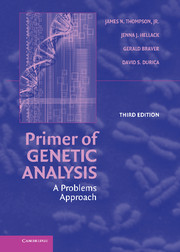Book contents
- Frontmatter
- Contents
- Preface
- Note on Genetic Symbols
- 1 Overview of Genetic Organization and Scale
- 2 Mitosis and Meiosis
- 3 Nucleic Acids: DNA and RNA
- 4 Basic Mendelian Genetics
- 5 Probability and Chi-Square
- 6 Sex-Linkage and Gene Interactions
- 7 Pedigree Analysis
- 8 Overview of Basic Statistical Testing
- 9 Quantitative Inheritance
- 10 Overview of Genetic Mapping
- 11 Assessing Chromosome Linkage Relationships
- 12 Linkage and Mapping in Diploids
- 13 Mapping in Bacteria and Viruses
- 14 Overview of Types of Genetic Change
- 15 Gene Mutation
- 16 Changes in Chromosome Number and Structure
- 17 Protein Synthesis and the Genetic Code
- 18 Gene Regulation and Development
- 19 Overview of Molecular Biology Techniques
- 20 DNA Mapping and Human Genome Analysis
- 21 Basic Population Genetics
- 22 Selection and Evolution
- 23 Practice Tests
- 24 Answers to Practice Tests and Crossword Puzzles
- 25 Landmarks in the History of Genetics
- Glossary
- Reference Tables
23 - Practice Tests
Published online by Cambridge University Press: 05 June 2012
- Frontmatter
- Contents
- Preface
- Note on Genetic Symbols
- 1 Overview of Genetic Organization and Scale
- 2 Mitosis and Meiosis
- 3 Nucleic Acids: DNA and RNA
- 4 Basic Mendelian Genetics
- 5 Probability and Chi-Square
- 6 Sex-Linkage and Gene Interactions
- 7 Pedigree Analysis
- 8 Overview of Basic Statistical Testing
- 9 Quantitative Inheritance
- 10 Overview of Genetic Mapping
- 11 Assessing Chromosome Linkage Relationships
- 12 Linkage and Mapping in Diploids
- 13 Mapping in Bacteria and Viruses
- 14 Overview of Types of Genetic Change
- 15 Gene Mutation
- 16 Changes in Chromosome Number and Structure
- 17 Protein Synthesis and the Genetic Code
- 18 Gene Regulation and Development
- 19 Overview of Molecular Biology Techniques
- 20 DNA Mapping and Human Genome Analysis
- 21 Basic Population Genetics
- 22 Selection and Evolution
- 23 Practice Tests
- 24 Answers to Practice Tests and Crossword Puzzles
- 25 Landmarks in the History of Genetics
- Glossary
- Reference Tables
Summary
MITOSIS AND MEIOSIS
Multiple Choice
Please select the single best answer for each of the following questions.
A human cell at prophase II of meiosis will normally have how many centromeres? (a) 46, (b) 45, (c) 92, (d) 23, (e) none of the above.
An individual carries a pair of homologous chromosomes, A and a. A cell at mitotic metaphase or at metaphase I of meiosis has (a) one A and one a chromosome, (b) two A and two a chromosomes, (c) four A and four a chromosomes, (d) none of the above.
A cell from the same individual at metaphase II of meiosis has (a) one A and one a chromosome, (b) either one A or one a chromosome, (c) two A and two a chromosomes, (d) either two A or two a chromosomes.
Bivalents are seen (a) at prophase I of meiosis, (b) at prophase II of meiosis, (c) at prophase of mitosis, (d) at prophase I of meiosis and at prophase of mitosis, (e) at prophase II of meiosis and at prophase of mitosis, (f) during the interphase just prior to the beginning of meiosis.
Histone proteins are found in (a) eukaryotes only, (b) bacteria only, (c) viruses only, (d) both eukaryotes and bacteria, but not viruses.
Centromeres associated with duplicated chromosomes (sister chromatids) do not divide during (a) mitotic anaphase, (b) anaphase I of meiosis, (c) anaphase II of meiosis.
A chromosome with a long arm and a short arm is called (a) telocentric, (b) egocentric, (c) epicentric, (d) metacentric, (e) acrocentric, (f) paracentric, (g) chromocentric.
[…]
- Type
- Chapter
- Information
- Primer of Genetic AnalysisA Problems Approach, pp. 236 - 254Publisher: Cambridge University PressPrint publication year: 2007



